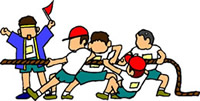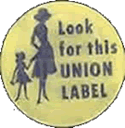
Grades 3-5

Don't have an account yet? Sign up for free
Don't have an account yet? Sign up for free


If you asked students what comes to mind first when they think of Labor Day, what do you think they would say? The last days of summer? A family picnic? Shopping the Labor Day sales? The purpose of this lesson is to broaden and deepen student understanding of the Labor Day holiday. Students will learn why workers organized unions during the nineteenth century to fight for higher pay and better working conditions. They will discover that unions help balance the power between workers and employers—yielding a better life for many workers and their families today. This is a great lesson to do just before Labor Day. If your school doesn’t begin till after the holiday, consider doing it on May 1—the International Worker’s Rights Day!
Ask the students if they have ever participated in a game of Tug-of-War. Discuss how the game is played. One person or a group of people hold one end of a rope while an equal number of people hold the opposite end of the rope. A mark is placed on the ground at the middle of the rope. The winner of the game is the side that can pull its opponent(s) across the mark on the ground.
group of people hold one end of a rope while an equal number of people hold the opposite end of the rope. A mark is placed on the ground at the middle of the rope. The winner of the game is the side that can pull its opponent(s) across the mark on the ground.
Have one student who you know is weaker than you come forward. Play Tug-of-War with this student. Some students will probably protest that the contest is unfair.
Discuss:
Why do you think it is unfair for me to play against this student? [The sides aren’t balanced in terms of strength.]
Explain that in the 1800s, mass production was introduced in the United States. Mass production means people worked together in factories to make goods in large quantities. The workers in these places worked long and hard for very little pay. The work was often dirty and dangerous. If workers dared to complain about their treatment, they were fired. Employers had a lot of power because there were always other people who needed a job and would be willing to do the work no matter how badly they were being treated.
It was like the Tug-of-War game just played. The workers did not think they were being treated fairly. The sides were not balanced.
Ask:
Prepare to repeat the Tug-of-War. This time have a few of the strongest students in class join you as employers on one side of the rope. Tell the rest of the students they represent the workers who will pull against you.
What do you think will happen this time? [The game will be fairer. There will be more balance and it will be harder for either side to win.]
Play again and point out that this is exactly what happened to the workers and employers. Workers realized if they joined together and formed labor unions they would have more power. There would be more balance between employers and workers.
Conclude the introductory activity by stating that the students will read about what happened when workers came together to fight for better treatment.
Instruct students to complete the online version of this lesson. They will read a story How Labor Got Its Day about the events that led to the creation of Labor Day in the United States.
 The students will learn that the establishment of the Labor Day holiday is really the beginning of the story. There were many things in the workplace that workers wanted to change. More unions were formed. Workers came together to bring attention to how they were being mistreated. They negotiated with employers and lobbied government to increase wages, reduce the hours people worked and improve working conditions. The results of their efforts can be seen in how workers are treated today.
The students will learn that the establishment of the Labor Day holiday is really the beginning of the story. There were many things in the workplace that workers wanted to change. More unions were formed. Workers came together to bring attention to how they were being mistreated. They negotiated with employers and lobbied government to increase wages, reduce the hours people worked and improve working conditions. The results of their efforts can be seen in how workers are treated today.
Students are asked to list five ways in which the lives of workers and families today are different from those on the first Labor Day. They are encouraged to return to the story How Labor Got Its Day to come up with their answers.
[Note to the teacher: When work in colonial America is mentioned in the slide presentation, there is a major omission, since no mention is made of indentured servants and slaves. Students who have studied early U.S. history may point this out. Of course, you may also want to call attention to this fact. Explain that after the agreed upon number of years, indentured servants were given their freedom and could work for themselves like anybody else. However, it was not until the Civil War that slaves had the same opportunities. African-Americans became and continue to be an important part of the labor movement.]
Ask the students:
What do you do on Labor Day?
Point out that today, Labor Day is celebrated with less fanfare than it was in its early days. Some cities have parades. But most people think of the holiday as the end of summer. Families take advantage of the three-day weekend and warm weather to take one last trip to the beach or have a barbecue. Stores have huge sales that encourage people to go shopping.
As the lives of workers have improved, people sometimes forget the connection between Labor Day and workers. Labor Day is a good time to think about how our lives are better because of working people – past and present.
Have the students share their responses as to how the lives of workers and families are different today than they were on the first Labor Day. If the students need prompting, these questions will help:
Clearly, by joining together, workers have better working conditions!
CobbleStone Magazine, a history magazine for kids aged 9-14, published an issue in 1992 titled "The History of Labor." The issue explores the early years of the Labor Movement including child labor, the formation of the AFL and its merge with the CIO, the Homestead Steel Strike, the establishment of the Brotherhood of Sleeping Car Porters and much more. Students may enjoy playing the board game, provided on pages 22-23. This publication is available for purchase here.
You might also encourage the students to:
1. Do a crossword puzzle that uses words found in the story they have just read. Here is the answer key .
2. Form groups and read a biography of a person who helped improve the lives of workers. Then produce a play that tells the person's story to the rest of the class. Suggested activists that span the nineteenth and twentieth centuries are Cesar Chavez, (Big) Annie Clemenc (of Calumet), Samuel Gompers, Lewis Hine, Mary Harris (Mother) Jones, A. Philip Randolph or Walter Reuther.

3. Create a label that could be put on all kinds of goods that would let people know they were union-made. An example is provided from the International Ladies Garment Workers Union during the 1970s. The ILGWU even had a song used in television ads to encourage the purchase of clothing with its label.
4. Write a letter thanking a worker who has made their lives better. This might be a school cafeteria worker, a crossing guard or even the person who made their favorite pair of sneakers!
Assess the students on their ability to identify ways in which the lives of workers and families have improved since the first Labor Day. You may also want to consider the students’ participation in class discussion.

Grades 3-5

Grades 9-12

Grades 9-12

Grades 9-12
